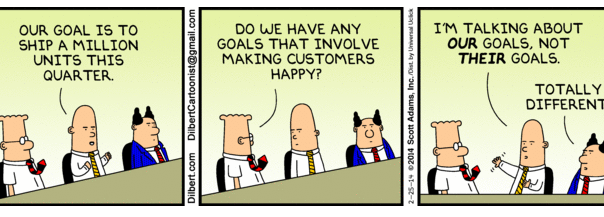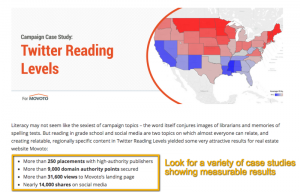Writing a follow-up email is hard. You’re working to snag the attention of a prospect who has an inbox full of droning provocations and unsolicited gloom, laden with demanding sales folks prodding them to take action they’d, more often than not, rather skip. Emails with real value tend to slip through the cracks.
The “Delete” response on cold emails is so fast today. An average buyer gets somewhere around +100 emails a day, but only opens 23 percent of them, according to a study by Tellwise. Moreover, that buyer is only clicking on 2 percent of them. But, according to SiriusDecisions, the average salesperson only makes two attempts to reach a prospect.
And I get it. You don’t want to be a pain in the keister. We all want to avoid being annoying at the risk of having to face rejection. But it’s our job to make sure we’re aligned with what our prospects want and need. The trick is to make your follow up email creative and useful so it doesn’t feel like a follow-up.
Here’s your 7 tips for the best follow-up email:
1. Know who you’re talking to.
Do a little research on who you’re dealing with in your email. Understand your persona so you can figure out how best to relate to them in your follow up email.
To get a heat check on your prospect, hit their social channels like LinkedIn, Twitter and Facebook to see what kind of content they’re responding to and how they’re responding to it. These channels will help you gauge what tone you can use to approach someone without offending them.
Humanize your approach. Talk to your prospect like a person, not just a number on the spreadsheet. Personalized emails improve click-through rates by 14 percent and boost conversion rates by as much as 10 percent, according to the Aberdeen Group.
2. Nail the subject line.
According to our friend Jay Baer over at Convince and Convert, some 33 percent of email recipients decide whether or not to open an email based on the subject line alone. It might seem like a tiny afterthought for your follow up email, but the subject line is the first impression you have on your recipients.
Creating a subject line is cinch. But creating a subject line that gets read? That’s a lot harder. Too many people lack creativity and end with a product like this:
Hello. My name is Annie of Arendelle. I’m with company XYZ. We specialize in…I can save you…for free!
If you’re going to be wasting your time and the prospects, then please continue sending opening lines like this. Nothing spells SPAM quite like a subject line with words like “free,” “trial,” “quick,” “limited,” or “save.” So skip those trigger words. If you’re following up on a cold email, keep it short and sweet. If you’ve had a previous conversation, inject part of your conversation into the header. The moment I read a subject line linking prior communication, I know it’s legit and not offering up a timeshare in the Bahamas. Your subject line counts, so don’t knee-jerk it.
3. Make the prospect your story’s hero.
Stop making your follow up email all about you. I know you can help solve a pain point and add value. You’re just trying to make an impact and <insert buzzword>. But if you can’t get their attention, you’ll end up with a fate no different than any of your competitors (hello, trash bin).
No one has to read your email.
Ask yourself why a prospect should care about what you have to offer. Shift the focus from what your product is to a solution answering their problem. Like Joanna Wiebe of Copy Hackers said, don’t amplify the act of progressing, amplify the value of it. Be customer-centric, look at what they need, what they want. And slide in your solution.


4. Get to the point. (And get there fast.)
In general, I think brevity always rules. As our friend Ann Handley said in Everybody Writes, if you can say something more simply, then you should. Skip the open-ended questions and be proactively specific in your messaging. If your goal is to schedule a meeting, then ask for it. Don’t waste the time of your recipient by beating around the bush.
People skim emails looking for the main highlights. Short paragraphs and bullets are great ways to make sure your key points are front and center. You have only a few seconds (8.5 seconds to be specific) to catch your reader’s attention. Get to the most important points, and get there fast.
5. Position your follow up email and value alignment.
The solution your company provides solves a real pain point for your prospect. You’re not selling something frivolous, you have something that will really help your prospect increase revenue. If only you can get them to listen and understand.
Some 70 percent of prospects make purchasing decisions to solve problems, while 30 percent make the decision to gain something. So reach out with confidence to align your product or service with their needs or wants.
6. Be human (and unexpected).
Most follow up email messages are straightforward and serious (and seriously boring). Mix in a little twist to craft the unexpected and get noticed. If you’ve done your research on the prospect and think they can handle it, throw in a little (tasteful) humor to mix things up. Get a pulse of their personality through their Twitter or Facebook – see what they’re talking about and what resonates with them.
Be aware, but not overly cautious. In general, if a prospect is ignoring you no matter what, sending a funny, unexpected message to show you’re still waiting on the other end is a great last-ditch effort.
And, bonus: According to Yes! 50 Scientifically Proven Ways to be More Persuasive, business people who send a funny, inoffensive cartoon to their negotiation partners before negotiating creates higher levels of trust and 15 percent larger profits than those who didn’t send a cartoon.
When a life raft of happiness in the form of something funny comes along, people are quick to get on board. But to paraphrase Shakespeare, too much of a good thing can be too much of a good thing. Try not to overuse humor in the sales process. It can become annoying or off-putting at a certain point.
7. Be relevant.
Stay up-to-date with your prospect’s LinkedIn profile. You never know if you can find a little tidbit of information that’s relevant to your geographic location, education or job history that can make the world a little smaller.
Tools like Google alerts can also keep you updated with the industry and a specific company. Mention and compliment their current content – like a blog post, ebook or case study. This shows you’re researching them and you actually care about the thought leadership your prospect brings to the table. Relevant emails drive 18 times more revenue than broadcast emails. Every business has data. Make it meaningful and actionable to tailor your messaging.
Business & Finance Articles on Business 2 Community(139)







